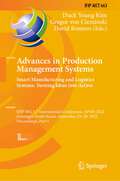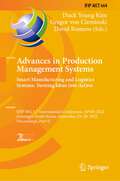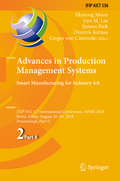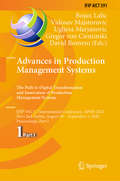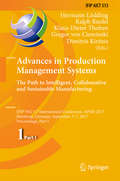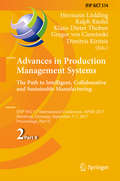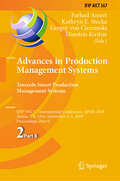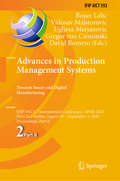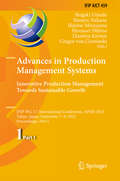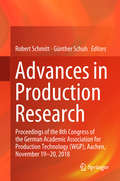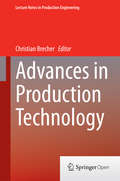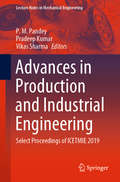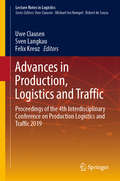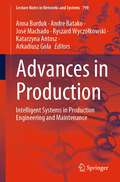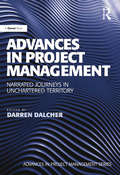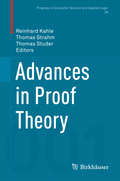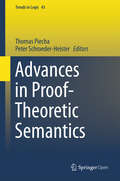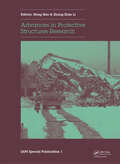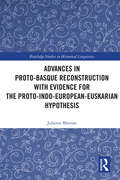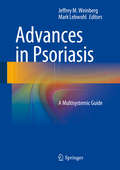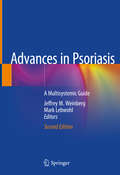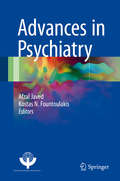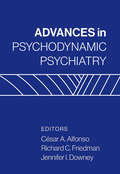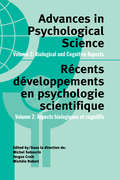- Table View
- List View
Advances in Production Management Systems. Smart Manufacturing and Logistics Systems: IFIP WG 5.7 International Conference, APMS 2022, Gyeongju, South Korea, September 25–29, 2022, Proceedings, Part I (IFIP Advances in Information and Communication Technology #663)
by Gregor Von Cieminski David Romero Duck Young KimThis two-volume set, IFIP AICT 663 and 664, constitutes the thoroughly refereed proceedings of the International IFIP WG 5.7 Conference on Advances in Production Management Systems, APMS 2022, held in Gyeongju, South Korea in September 2022.The 139 full papers presented in these volumes were carefully reviewed and selected from a total of 153 submissions. The papers of APMS 2022 are organized into two parts. The topics of special interest in the first part included: AI & Data-driven Production Management; Smart Manufacturing & Industry 4.0; Simulation & Model-driven Production Management; Service Systems Design, Engineering & Management; Industrial Digital Transformation; Sustainable Production Management; and Digital Supply Networks. The second part included the following subjects: Development of Circular Business Solutions and Product-Service Systems through Digital Twins; “Farm-to-Fork” Production Management in Food Supply Chains; Urban Mobility and City Logistics; Digital Transformation Approaches in Production Management; Smart Supply Chain and Production in Society 5.0 Era; Service and Operations Management in the Context of Digitally-enabled Product-Service Systems; Sustainable and Digital Servitization; Manufacturing Models and Practices for Eco-Efficient, Circular and Regenerative Industrial Systems; Cognitive and Autonomous AI in Manufacturing and Supply Chains; Operators 4.0 and Human-Technology Integration in Smart Manufacturing and Logistics Environments; Cyber-Physical Systems for Smart Assembly and Logistics in Automotive Industry; and Trends, Challenges and Applications of Digital Lean Paradigm.
Advances in Production Management Systems. Smart Manufacturing and Logistics Systems: IFIP WG 5.7 International Conference, APMS 2022, Gyeongju, South Korea, September 25–29, 2022, Proceedings, Part II (IFIP Advances in Information and Communication Technology #664)
by Gregor Von Cieminski David Romero Duck Young KimThis two-volume set, IFIP AICT 663 and 664, constitutes the thoroughly refereed proceedings of the International IFIP WG 5.7 Conference on Advances in Production Management Systems, APMS 2022, held in Gyeongju, South Korea in September 2022.The 139 full papers presented in these volumes were carefully reviewed and selected from a total of 153 submissions. The papers of APMS 2022 are organized into two parts. The topics of special interest in the first part included: AI & Data-driven Production Management; Smart Manufacturing & Industry 4.0; Simulation & Model-driven Production Management; Service Systems Design, Engineering & Management; Industrial Digital Transformation; Sustainable Production Management; and Digital Supply Networks. The second part included the following subjects: Development of Circular Business Solutions and Product-Service Systems through Digital Twins; “Farm-to-Fork” Production Management in Food Supply Chains; Urban Mobility and City Logistics; Digital Transformation Approaches in Production Management; Smart Supply Chain and Production in Society 5.0 Era; Service and Operations Management in the Context of Digitally-enabled Product-Service Systems; Sustainable and Digital Servitization; Manufacturing Models and Practices for Eco-Efficient, Circular and Regenerative Industrial Systems; Cognitive and Autonomous AI in Manufacturing and Supply Chains; Operators 4.0 and Human-Technology Integration in Smart Manufacturing and Logistics Environments; Cyber-Physical Systems for Smart Assembly and Logistics in Automotive Industry; and Trends, Challenges and Applications of Digital Lean Paradigm.
Advances in Production Management Systems. Smart Manufacturing for Industry 4.0: IFIP WG 5.7 International Conference, APMS 2018, Seoul, Korea, August 26-30, 2018, Proceedings, Part II (IFIP Advances in Information and Communication Technology #536)
by Dimitris Kiritsis Gregor Von Cieminski Ilkyeong Moon Gyu M. Lee Jinwoo ParkThe two-volume set IFIP AICT 535 and 536 constitutes the refereed proceedings of the International IFIP WG 5.7 Conference on Advances in Production Management Systems, APMS 2018, held in Seoul, South Korea, in August 2018.The 129 revised full papers presented were carefully reviewed and selected from 149 submissions. They are organized in the following topical sections: lean and green manufacturing; operations management in engineer-to-order manufacturing; product-service systems, customer-driven innovation and value co-creation; collaborative networks; smart production for mass customization; global supply chain management; knowledge based production planning and control; knowledge based engineering; intelligent diagnostics and maintenance solutions for smart manufacturing; service engineering based on smart manufacturing capabilities; smart city interoperability and cross-platform implementation; manufacturing performance management in smart factories; industry 4.0 - digital twin; industry 4.0 - smart factory; and industry 4.0 - collaborative cyber-physical production and human systems.
Advances in Production Management Systems. The Path to Digital Transformation and Innovation of Production Management Systems: IFIP WG 5.7 International Conference, APMS 2020, Novi Sad, Serbia, August 30 – September 3, 2020, Proceedings, Part I (IFIP Advances in Information and Communication Technology #591)
by Gregor Von Cieminski Vidosav Majstorovic David Romero Bojan Lalic Ugljesa MarjanovicThe two-volume set IFIP AICT 591 and 592 constitutes the refereed proceedings of the International IFIP WG 5.7 Conference on Advances in Production Management Systems, APMS 2020, held in Novi Sad, Serbia, in August/September 2020.The 164 papers presented were carefully reviewed and selected from 199 submissions. They discuss globally pressing issues in smart manufacturing, operations management, supply chain management, and Industry 4.0. The papers are organized in the following topical sections: Part I: advanced modelling, simulation and data analytics in production and supply networks; advanced, digital and smart manufacturing; digital and virtual quality management systems; cloud-manufacturing; cyber-physical production systems and digital twins; IIOT interoperability; supply chain planning and optimization; digital and smart supply chain management; intelligent logistics networks management; artificial intelligence and blockchain technologies in logistics and DSN; novel production planning and control approaches; machine learning and artificial intelligence; connected, smart factories of the future; manufacturing systems engineering: agile, flexible, reconfigurable; digital assistance systems: augmented reality and virtual reality; circular products design and engineering; circular, green, sustainable manufacturing; environmental and social lifecycle assessments; socio-cultural aspects in production systems; data-driven manufacturing and services operations management; product-service systems in DSN; and collaborative design and engineering Part II: the Operator 4.0: new physical and cognitive evolutionary paths; digital transformation approaches in production management; digital transformation for more sustainable supply chains; data-driven applications in smart manufacturing and logistics systems; data-driven services: characteristics, trends and applications; the future of lean thinking and practice; digital lean manufacturing and its emerging practices; new reconfigurable, flexible or agile production systems in the era of industry 4.0; operations management in engineer-to-order manufacturing; production management in food supply chains; gastronomic service system design; product and asset life cycle management in the circular economy; and production ramp-up strategies for product
Advances in Production Management Systems. The Path to Intelligent, Collaborative and Sustainable Manufacturing: IFIP WG 5.7 International Conference, APMS 2017, Hamburg, Germany, September 3-7, 2017, Proceedings, Part I (IFIP Advances in Information and Communication Technology #513)
by Hermann Lödding Klaus-Dieter Thoben Dimitris Kiritsis Gregor Von Cieminski Ralph RiedelThe two-volume set IFIP AICT 513 and 514 constitutes the refereed proceedings of the International IFIP WG 5. 7 Conference on Advances in Production Management Systems, APMS 2017, held in Hamburg, Germany, in September 2017. The 121 revised full papers presented were carefully reviewed and selected from 163 submissions. They are organized in the following topical sections: smart manufacturing system characterization; product and asset life cycle management in smart factories of industry 4. 0; cyber-physical (IIoT) technology deployments in smart manufacturing systems; multi-disciplinary collaboration in the development of smart product-service solutions; sustainable human integration in cyber-physical systems: the operator 4. 0; intelligent diagnostics and maintenance solutions; operations planning, scheduling and control; supply chain design; production management in food supply chains; factory planning; industrial and other services; operations management in engineer-to-order manufacturing; gamification of complex systems design development; lean and green manufacturing; and eco-efficiency in manufacturing operations.
Advances in Production Management Systems. The Path to Intelligent, Collaborative and Sustainable Manufacturing: IFIP WG 5.7 International Conference, APMS 2017, Hamburg, Germany, September 3-7, 2017, Proceedings, Part II (IFIP Advances in Information and Communication Technology #514)
by Hermann Lödding Klaus-Dieter Thoben Dimitris Kiritsis Gregor Von Cieminski Ralph RiedelThe two-volume set IFIP AICT 513 and 514 constitutes the refereed proceedings of the International IFIP WG 5. 7 Conference on Advances in Production Management Systems, APMS 2017, held in Hamburg, Germany, in September 2017. The 121 revised full papers presented were carefully reviewed and selected from 163 submissions. They are organized in the following topical sections: smart manufacturing system characterization; product and asset life cycle management in smart factories of industry 4. 0; cyber-physical (IIoT) technology deployments in smart manufacturing systems; multi-disciplinary collaboration in the development of smart product-service solutions; sustainable human integration in cyber-physical systems: the operator 4. 0; intelligent diagnostics and maintenance solutions; operations planning, scheduling and control; supply chain design; production management in food supply chains; factory planning; industrial and other services; operations management in engineer-to-order manufacturing; gamification of complex systems design development; lean and green manufacturing; and eco-efficiency in manufacturing operations.
Advances in Production Management Systems. Towards Smart Production Management Systems: IFIP WG 5.7 International Conference, APMS 2019, Austin, TX, USA, September 1–5, 2019, Proceedings, Part II (IFIP Advances in Information and Communication Technology #567)
by Dimitris Kiritsis Gregor Von Cieminski Farhad Ameri Kathryn E. SteckeThe two-volume set IFIP AICT 566 and 567 constitutes the refereed proceedings of the International IFIP WG 5.7 Conference on Advances in Production Management Systems, APMS 2019, held in Austin, TX, USA.The 161 revised full papers presented were carefully reviewed and selected from 184 submissions. They discuss globally pressing issues in smart manufacturing, operations management, supply chain management, and Industry 4.0. The papers are organized in the following topical sections: lean production; production management in food supply chains; sustainability and reconfigurability of manufacturing systems; product and asset life cycle management in smart factories of industry 4.0; variety and complexity management in the era of industry 4.0; participatory methods for supporting the career choices in industrial engineering and management education; blockchain in supply chain management; designing and delivering smart services in the digital age; operations management in engineer-to-order manufacturing; the operator 4.0 and the Internet of Things, services and people; intelligent diagnostics and maintenance solutions for smart manufacturing; smart supply networks; production management theory and methodology; data-driven production management; industry 4.0 implementations; smart factory and IIOT; cyber-physical systems; knowledge management in design and manufacturing; collaborative product development; ICT for collaborative manufacturing; collaborative technoloy; applications of machine learning in production management; and collaborative technology.
Advances in Production Management Systems. Towards Smart and Digital Manufacturing: IFIP WG 5.7 International Conference, APMS 2020, Novi Sad, Serbia, August 30 – September 3, 2020, Proceedings, Part II (IFIP Advances in Information and Communication Technology #592)
by Gregor Von Cieminski Vidosav Majstorovic David Romero Bojan Lalic Ugljesa MarjanovicThe two-volume set IFIP AICT 591 and 592 constitutes the refereed proceedings of the International IFIP WG 5.7 Conference on Advances in Production Management Systems, APMS 2020, held in Novi Sad, Serbia, in August/September 2020. The 164 papers presented were carefully reviewed and selected from 199 submissions. They discuss globally pressing issues in smart manufacturing, operations management, supply chain management, and Industry 4.0. The papers are organized in the following topical sections: Part I: advanced modelling, simulation and data analytics in production and supply networks; advanced, digital and smart manufacturing; digital and virtual quality management systems; cloud-manufacturing; cyber-physical production systems and digital twins; IIOT interoperability; supply chain planning and optimization; digital and smart supply chain management; intelligent logistics networks management; artificial intelligence and blockchain technologies in logistics and DSN; novel production planning and control approaches; machine learning and artificial intelligence; connected, smart factories of the future; manufacturing systems engineering: agile, flexible, reconfigurable; digital assistance systems: augmented reality and virtual reality; circular products design and engineering; circular, green, sustainable manufacturing; environmental and social lifecycle assessments; socio-cultural aspects in production systems; data-driven manufacturing and services operations management; product-service systems in DSN; and collaborative design and engineering Part II: the Operator 4.0: new physical and cognitive evolutionary paths; digital transformation approaches in production management; digital transformation for more sustainable supply chains; data-driven applications in smart manufacturing and logistics systems; data-driven services: characteristics, trends and applications; the future of lean thinking and practice; digital lean manufacturing and its emerging practices; new reconfigurable, flexible or agile production systems in the era of industry 4.0; operations management in engineer-to-order manufacturing; production management in food supply chains; gastronomic service system design; product and asset life cycle management in the circular economy; and production ramp-up strategies for product
Advances in Production Management Systems: IFIP WG 5.7 International Conference, APMS 2015, Tokyo, Japan, September 7-9, 2015, Proceedings, Part I (IFIP Advances in Information and Communication Technology #459)
by Shigeki Umeda Masaru Nakano Hajime Mizuyama Hironori Hibino Dimitris Kiritsis Gregor Von CieminskiThe two volumes IFIP AICT 459 and 460 constitute the refereed proceedings of the International IFIP WG 5. 7 Conference on Advances in Production Management Systems, APMS 2015, held in Tokyo, Japan, in September 2015. The 163 revised full papers were carefully reviewed and selected from 185 submissions. They are organized in the following topical sections: collaborative networks; globalization and production management; knowledge based production management; project management, engineering management, and quality management; sustainability and production management; co-creating sustainable business processes and ecosystems; open cloud computing architecture for smart manufacturing and cyber physical production systems; the practitioner's view on "innovative production management towards sustainable growth"; the role of additive manufacturing in value chain reconfiguration and sustainability; operations management in engineer-to-order manufacturing; lean production; sustainable system design for green products; cloud-based manufacturing; ontology-aided production - towards open and knowledge-driven planning and control; product-service lifecycle management: knowledge-driven innovation and social implications; and service engineering.
Advances in Production Research: Proceedings of the 8th Congress of the German Academic Association for Production Technology (WGP), Aachen, November 19-20, 2018
by Günther Schuh Robert SchmittThe papers in this volume present recent and highly relevant topics in the fields of production research as 3D printing, additive manufacturing processes, agile product development, change dynamics in companies, configurable material systems, data analysis in process optimization, future technologies with high potential in value creation, global production, learning production systems, production of the future, organization of assemblies, resource efficiency in production, robotics in assembly, and technology trends in machine tools. Researchers and practitioners in the field of mechanical engineering and production technology will benefit from this content.
Advances in Production Technology (Lecture Notes in Production Engineering)
by Christian BrecherThis edited volume contains the selected papers presented at the scientific board meeting of the German Cluster of Excellence on Integrative Production Technology for High-Wage Countries, held in November 2014. The topical structure of the book is clustered in six sessions: Integrative Production Technology, Individualised Production, Virtual Production Systems, Integrated Technologies, Self-Optimising Production Systems and Human Factors in Production Technology. The Aachen perspective on a holistic theory of production is complemented by conference papers from external leading researchers in the fields of production, materials science and bordering disciplines. The target audience primarily comprises research experts and practitioners in the field but the book may also be beneficial for graduate students. "
Advances in Production and Industrial Engineering: Select Proceedings of ICETMIE 2019 (Lecture Notes in Mechanical Engineering)
by Pradeep Kumar Vikas Sharma P. M. PandeyThis book comprises the select proceedings of the International Conference on Emerging Trends in Mechanical and Industrial Engineering (ICETMIE) 2019. The conference covers current trends in thermal, design, industrial, production and other sub-disciplines of mechanical engineering. This volume focuses on different industrial and production engineering areas such as additive manufacturing, rapid prototyping, computer aided engineering, advanced manufacturing processes, manufacturing management and automation, sustainable manufacturing systems, metrology, manufacturing process optimization, operations research and decision-making models, production planning and inventory control, supply chain management, and quality engineering. The contents of this book will be useful for students, researchers and other professionals interested in industrial and production engineering.
Advances in Production, Logistics and Traffic: Proceedings Of The 4th Interdisciplinary Conference On Production Logistics And Traffic 2019 (Lecture Notes in Logistics)
by Uwe Clausen Sven Langkau Felix KreuzThe series of Interdisciplinary Conferences on Production, Logistics and Traffic (ICPLT) address the research community as well as practitioners in these fields with special attention to links and interfaces between the three disciplines. The fourth ICPLT in particular deals with technology from intralogistics to automated trucking driving as well as the societal aspects of commercial transport. <P><P> To contribute to a high-level and beneficial exchange between authorities in politics and municipalities with researchers and practitioners in production and logistics management the ICPLT has asked for contributions from the three disciplines to better understand innovative technologies, best practises and latest results. These contributions have been evaluated and selected based on a double-blind review process to become part of this book. It comprises 21 contributions examining trends and challenges for commercial transport as the essential link for production, logistics and society. Therefore, innovative technologies and strategies are presented and discussed to better understand the interdependencies, conflicts of interest and to develop feasible solutions.
Advances in Production: Intelligent Systems in Production Engineering and Maintenance (Lecture Notes in Networks and Systems #790)
by Anna Burduk José Machado Andre Batako Arkadiusz Gola Ryszard Wyczółkowski Katarzyna AntoszThis book discusses the papers presented at Conference ISPEM 2023 which was organized by Wrocław University of Science and Technology, Liverpool John Moores University, and University of Minho. The conference gave an opportunity to exchange experiences in intelligent systems and tools in production, and maintenance, especially its practical application.
Advances in Project Management: Narrated Journeys In Uncharted Territory (Advances In Project Management Ser.)
by Darren DalcherAdvances in Project Management
Advances in Proof Theory (Progress in Computer Science and Applied Logic #28)
by Thomas Studer Thomas Strahm Reinhard KahleThe aim of this volume is to collect original contributions by the best specialists from the area of proof theory, constructivity, and computation and discuss recent trends and results in these areas. Some emphasis will be put on ordinal analysis, reductive proof theory, explicit mathematics and type-theoretic formalisms, and abstract computations. The volume is dedicated to the 60th birthday of Professor Gerhard Jäger, who has been instrumental in shaping and promoting logic in Switzerland for the last 25 years. It comprises contributions from the symposium "Advances in Proof Theory", which was held in Bern in December 2013. Proof theory came into being in the twenties of the last century, when it was inaugurated by David Hilbert in order to secure the foundations of mathematics. It was substantially influenced by Gödel's famous incompleteness theorems of 1930 and Gentzen's new consistency proof for the axiom system of first order number theory in 1936. Today, proof theory is a well-established branch of mathematical and philosophical logic and one of the pillars of the foundations of mathematics. Proof theory explores constructive and computational aspects of mathematical reasoning; it is particularly suitable for dealing with various questions in computer science.
Advances in Proof-Theoretic Semantics (Trends in Logic #43)
by Thomas Piecha Peter Schroeder-HeisterThis volume is the first ever collection devoted to the field of proof-theoretic semantics. Contributions address topics including the systematics of introduction and elimination rules and proofs of normalization, the categorial characterization of deductions, the relation between Heyting's and Gentzen's approaches to meaning, knowability paradoxes, proof-theoretic foundations of set theory, Dummett's justification of logical laws, Kreisel's theory of constructions, paradoxical reasoning, and the defence of model theory. The field of proof-theoretic semantics has existed for almost 50 years, but the term itself was proposed by Schroeder-Heister in the 1980s. Proof-theoretic semantics explains the meaning of linguistic expressions in general and of logical constants in particular in terms of the notion of proof. This volume emerges from presentations at the Second International Conference on Proof-Theoretic Semantics in Tübingen in 2013, where contributing authors were asked to provide a self-contained description and analysis of a significant research question in this area. The contributions are representative of the field and should be of interest to logicians, philosophers, and mathematicians alike.
Advances in Protective Structures Research
by Hong Hao Zhong-Xian LiThe International Association of Protective Structures (IAPS) was launched on 1 October 2010 in Manchester, UK during the first International Conference of Protective Structures. The primary purpose of IAPS is to bring researchers and engineers working in the area of protective structures together, and to promote research and development work for b
Advances in Proto-Basque Reconstruction with Evidence for the Proto-Indo-European-Euskarian Hypothesis (Routledge Studies in Historical Linguistics)
by Juliette BlevinsThis book presents a new reconstruction of Proto-Basque, the mother language of modern Basque varieties, historical Basque, and Aquitanian, grounded in traditional methods of historical linguistics. Building on a long tradition of Basque scholarship, the comparative method and internal reconstruction, informed by the phonetic bases of sound change and phonological typology, are used to explain previously underappreciated alternations and asymmetries in Basque sound patterns, resulting in a radically new view of the proto-language. The comparative method is then used to compare this new Proto-Basque with Proto-Indo-European, revealing regular sound correspondences in basic vocabulary and grammatical formatives. Evaluation of these results supports a distant genetic relationship between Proto-Basque and Proto-Indo-European, and offers new insights into specific linguistic properties of these two ancient languages. This comprehensive volume, which includes a detailed appendix including Proto-Basque/Proto-Indo-European cognate sets, will be of general interest to linguists, archeologists, historians, and geneticists, and of particular interest to scholars in historical linguistics, phonetics and phonology, language change, and Basque and Indo-European studies.
Advances in Psoriasis: A Multisystemic Guide
by Jeffrey M. Weinberg Mark LebwohlIt has become increasingly clear that psoriatic disease, both of the skin and joints, can be a significant diagnostic and therapeutic challenge for the physician and a debilitating illness for the patient. Genetic and immunologic advances have increased our understanding of the pathophysiology of psoriasis and psoriatic arthritis and there is a need for practically oriented evidence based references to describe the management options open to clinicians. The speed at which developments are occurring in the field also necessitates a novel approach to keeping up with these changes in practice and the need is for a reference that that be updated regularly as the subject requires. Psoriasis is an incredibly fast-moving discipline within dermatology. Guidelines, treatment options and management all change at incredible speed. There is a requirement to provide a comprehensive reference resource to provide practical, user friendly information for the dermatology profession to aid in the decision-making process. Psoriasis is a graphical subdiscipline of medicine and therefore this will have copious illustrations. As a fast moving discipline the emphasis must be on annual updates to ensure that readers are kept up to date on the important areas of development.
Advances in Psoriasis: A Multisystemic Guide
by Jeffrey M. Weinberg Mark LebwohlThis extensively revised second edition provides an up-to-date and highly informative textbook on psoriasis. The understanding of the mechanisms behind the disease and the available treatment options have continued to develop rapidly in recent times, with this vital resource covering the latest in these management options, including targeted T-cell therapy, the use of immunomodulators, systemic therapies, and ultraviolet and laser therapy. In addition, it provides a detailed overview of the pathophysiology, comorbidities, epidemiology and triggers of the disease. Advances in Psoriasis: A Multisystemic Guide extensively details the scientific basis and practice management of psoriasis. It is therefore a vital resource for practicing and trainee dermatologists looking to develop their clinical knowledge of how to manage and treat these patients.
Advances in Psychiatry
by Kostas N. Fountoulakis Afzal JavedThis book will be the newest edition on the series ‘advances in psychiatry’. The previous 3 volumes can be found online at http://www.wpanet.org/detail.php?section_id=10&content_id=660 . They were highly successful in covering a broad area of psychiatry from different perspectives and angles and by reflecting both specialized but also international and global approaches. This series have guaranteed quality therefore can be used by different scientific groups for teaching and learning and also as a means for fast dissemination of advanced research and transformation of research findings into the everyday clinical practice. There is already a body of readers anticipating the next volume.
Advances in Psychodynamic Psychiatry
by Jennifer I. Downey César A. Alfonso Dr Richard C. FriedmanBringing together important articles from Psychodynamic Psychiatry, this volume shows how contemporary practitioners are using a multidimensional biopsychosocial approach to increase the robustness of clinical research and the effectiveness of patient care. Chapters review cutting-edge approaches to formulating anxiety and mood disorders, eating disorders, traumatic grief, substance use and addictive behaviors, obsessive–compulsive disorder, personality disorders, schizophrenia, somatic symptom disorders, and trauma and stressor-related disorders. Treatment of specific populations is addressed, including infants and parents, children, spouses of the chronically ill, survivors of intimate partner violence, criminal offenders, and the elderly. Featuring rich case illustrations, the book integrates psychoanalytic concepts with advances in knowledge about neuroscience, gene–environment interactions, and the physiological impact of adversity.
Advances in Psychological Science, Volume 2: Biological and Cognitive Aspects
by Michel Sabourin Fergus Craik Michèle RobertThe chapters in this volume are the edited versions of invited addresses to the XXVI International Congress of Psychology held in Montréal in August 1996. As one major goal of the Congress was to promote communication among specializations in scientific psychology, the speakers were asked to survey their research area and present their own work in a way that would be accessible to their colleagues in other areas. Another purpose of the meeting was to bring researchers together from different parts of the world, reflecting their different approaches to the scientific study of mind, brain, and behavior. Consequently, the eminent researchers who have written the twenty-six chapters included in the present volume were drawn from universities and research institutes in North America, Europe, Japan, Russia, Israel, and New Zealand. The chapters cover a range of topics in human and animal experimental psychology. The first section deals with psychobiological processes - the interplay of body and mind in determining intelligence, stress, and pain. The next five chapters address current issues in neuropsychology and neuroscience, including the neural correlates of attention and vision. A third section looks at learning processes in humans and animals, and a fourth deals with a range of topics in perception and cognition. The final five chapters take a developmental perspective, presenting theoretical and empirical analyses of the acquisition of perceptual and cognitive abilities. Overall, the collection illustrates the growing trend to break down traditional barriers between areas of experimental psychology; there are many instances of profitable interactions between researchers studying aspects of behavior and those studying the biological bases of these behaviors. The twenty-six chapters give an excellent overview of current research in scientific psychology.
Advances in Psychology and Law (Advances in Psychology and Law #6)
by Brian H. Bornstein Monica K. Miller David DeMatteoThis edited volume presents nine new state-of-the-science chapters covering topics relevant to psychology and law, from established and emerging researchers in the field. Relevant to researchers, clinical practitioners, and policy makers, topics include discussions of rape and sexual assault, eyewitness identification, body-worn cameras, forensic gait analysis, evaluations and assessments, veteran’s experiences, therapeutic animals and wrongful convictions.
